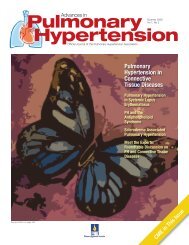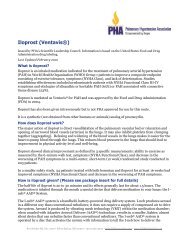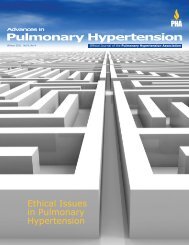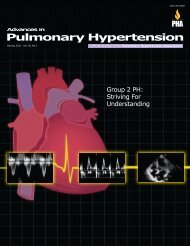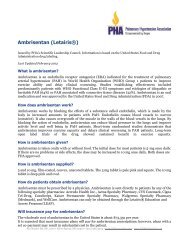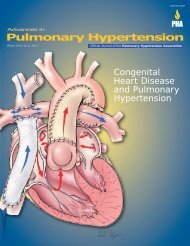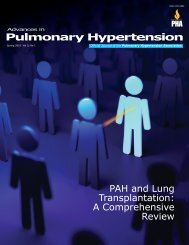Vol 7, No 3 - PHA Online University
Vol 7, No 3 - PHA Online University
Vol 7, No 3 - PHA Online University
You also want an ePaper? Increase the reach of your titles
YUMPU automatically turns print PDFs into web optimized ePapers that Google loves.
Continuing Medical Education Section<br />
Animal Models of Human Severe PAH<br />
Ivan F. McMurtry, PhD<br />
Departments of Pharmacology and<br />
Medicine and Center for Lung Biology<br />
<strong>University</strong> of South Alabama<br />
Mobile, Alabama, USA<br />
Ivan F. McMurtry, PhD<br />
Based on differences in clinical presentation, diagnostic findings,<br />
and response to treatment, human pulmonary hypertension (PH)<br />
has been subdivided into 5 categories. These include 1 :<br />
• Pulmonary arterial hypertension (PAH)<br />
• PH with left-sided heart disease<br />
• PH associated with respiratory disorders and/or hypoxemia<br />
• PH caused by chronic thrombotic and/or embolic disease<br />
• PH caused by miscellaneous other disorders affecting the<br />
pulmonary vasculature.<br />
The PAH category encompasses the idiopathic and familial<br />
forms of PH as well as those that occurr secondarily to several<br />
other diseases or conditions, including connective tissue disease,<br />
congenital systemic-to-pulmonary shunts, HIV infection, portal<br />
hypertension, hemoglobinopathies, and ingestion of drugs and<br />
toxins. This group also includes pulmonary veno-occlusive disease,<br />
pulmonary capillary hemangiomatosis, and persistent pulmonary<br />
hypertension of the newborn.<br />
Address for reprints and other correspondence: Ivan F. McMurtry, PhD, Professor,<br />
Departments of Pharmacology and Medicine and Center for Lung Biology,<br />
<strong>University</strong> of South Alabama, 307 N. <strong>University</strong> Blvd., Mobile, AL<br />
36688; email: ifmcmurtry@usouthal.edu.<br />
Characteristics of PAH<br />
While any form of PH can contribute to patient debilitation and<br />
mortality, PAH is a particularly severe and progressive form that<br />
frequently leads to right heart failure and premature death. 2-4 The<br />
pathogenesis of the increased precapillary pulmonary vascular resistance<br />
(PVR) is generally ascribed to combined effects of vasoconstriction,<br />
arterial wall remodeling, and in situ thrombosis. 5-8<br />
What appears to distinguish PAH from other forms of PH is the<br />
severity of the arteriopathy. Whereas the early phase of PAH has<br />
been described as histologically nonspecific, showing medial hypertrophy<br />
and mild intimal thickening of muscular pulmonary arteries,<br />
the later more progressive stage involves formation of<br />
complex cellular and fibrotic neointimal and plexiform lesions that<br />
obstruct and obliterate medium and small pulmonary arteries and<br />
arterioles. 9-13 This cellular and fibrotic luminal obliteration presumably<br />
accounts for the poor responsiveness of most adult PAH<br />
patients to acute administration of conventional pulmonary vasodilators,<br />
and the irreversibility of the hypertension following<br />
corrective surgery in some PAH patients with congenital heart<br />
diseases. 12-16<br />
Current Treatment of PAH<br />
The goals for the treatment of PAH are to reduce PVR and pulmonary<br />
arterial pressure, and thereby to reverse the pressure overload<br />
of the right ventricle to prevent failure and death. 2,3,17 In<br />
addition to adjunctive therapy with anticoagulants, diuretics, inotropes,<br />
and supplemental oxygen, patients with PAH who are not<br />
candidates for calcium channel blockers are currently treated with<br />
prostacyclin analogs, endothelin-1 receptor blockers, and/or phosphodiesterase<br />
type 5 inhibitors. This treatment improves symptoms<br />
and quality of life, but a recent meta-analysis of several<br />
clinical trials of these agents in patients with severe PAH showed<br />
only moderate reductions in PVR and pulmonary arterial pressure.<br />
18,19 There was no statistically significant decrease in mortality.<br />
These disappointing results do not duplicate those found in<br />
animal studies, which show that these classes of drugs, and numerous<br />
others, largely prevent and in some cases reverse chronic<br />
hypoxia- and monocrotaline-induced PH in rats. 20-23<br />
Classical Animal Models of PH<br />
The limitations of using chronically hypoxic and monocrotaline-injected<br />
rats as models of human severe PAH have been previously<br />
discussed. 22,24-28 The PH in these models is due largely to sustained<br />
vasoconstriction. 29-31 <strong>No</strong>tably, there is no formation of obstructive<br />
intimal lesions in the peripheral pulmonary arteries.<br />
Whether there is loss, rarefaction, of pulmonary microvessels, or<br />
simply impaired filling of these vessels with indicator due to<br />
spasm of upstream hypertensive arteries, is controversial. 31-33 In<br />
any case, it is apparent that preventing or reversing the sustained<br />
constriction and increased muscularization and adventitial thickening<br />
of pulmonary arteries in these 2 rodent models is not equivalent<br />
to “dissolving” the obliterative neointimal and other complex<br />
vascular lesions, and/or reversing unconventional mechanisms of<br />
vasoconstriction, that seemingly account for the high pulmonary<br />
vascular resistance (PVR) in human severe PAH. The same limitations<br />
apply to chronically hypoxic and monocrotaline pyrrole-injected<br />
mice, which typically show even less pulmonary artery<br />
346 Advances in Pulmonary Hypertension



